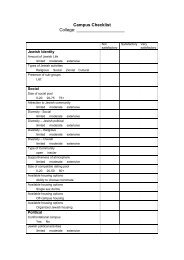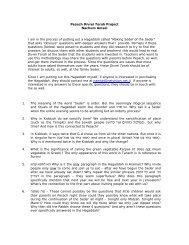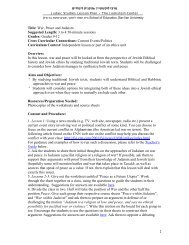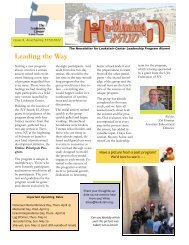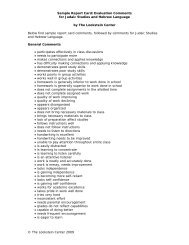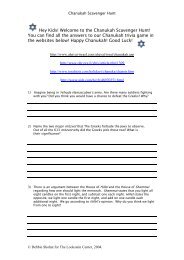FUNDAMENTAL CONCEPTS of the CLASSICAL HEBREW VERB
FUNDAMENTAL CONCEPTS of the CLASSICAL HEBREW VERB
FUNDAMENTAL CONCEPTS of the CLASSICAL HEBREW VERB
Create successful ePaper yourself
Turn your PDF publications into a flip-book with our unique Google optimized e-Paper software.
Chapter 1<br />
INTRODUCTION<br />
1.1 The verb and how and why it varies. Outline.<br />
A verb usually describes an action. (To avoid complications that may arise fur<strong>the</strong>r on, we will leave aside<br />
verbs that perform a different function.) Variations on this central concept inform us who performs <strong>the</strong> action,<br />
when it is performed, or if we are considering <strong>the</strong> action in itself, whe<strong>the</strong>r it is a statement about it in a particular<br />
case, or a command to perform it, and so on.<br />
In Classical Hebrew, as in Latin and Greek, <strong>the</strong>se variations are usually expressed by taking <strong>the</strong> ‘root’ <strong>of</strong> <strong>the</strong><br />
verb and modifying it by adding prefixes or suffixes, changing <strong>the</strong> vowels inside <strong>the</strong> word, doubling syllables or<br />
consonants, and so on. The final result in each case is still one word, and producing <strong>the</strong>se variations is called<br />
‘inflexion’ (or ‘inflection’) or ‘conjugation’.<br />
In a language such as English, <strong>the</strong>se variations are mostly (but not entirely) expressed not by inflexion but by<br />
<strong>the</strong> use <strong>of</strong> auxiliary words, mainly pronouns and auxiliary verbs. Producing a set <strong>of</strong> <strong>the</strong>se variations is not<br />
‘inflexion’, but <strong>the</strong> word ‘conjugation’ is still sometimes used by analogy with o<strong>the</strong>r languages. French lies<br />
somewhere in between, with far more inflexion than English, but far less than Latin.<br />
Inflexion, <strong>the</strong> variation <strong>of</strong> <strong>the</strong> form <strong>of</strong> a word to convey differences <strong>of</strong> meaning in application, while<br />
maintaining <strong>the</strong> essential meaning, applies also to nouns and adjectives, where it is not called ‘conjugation’ but<br />
‘declension’. In Latin this is quite complicated, in German it is impossibly so, but in Hebrew it is really<br />
comparatively simple - even so, it does not concern us here. We mention it only to explain that <strong>the</strong> study <strong>of</strong> <strong>the</strong><br />
variation <strong>of</strong> all such words - declension <strong>of</strong> nouns and adjectives toge<strong>the</strong>r with conjugation <strong>of</strong> verbs - all types <strong>of</strong><br />
inflexion in a language, is called ‘accidence’. This too we mention only to contrast it with ‘syntax’, <strong>the</strong> study not<br />
<strong>of</strong> words in <strong>the</strong>mselves but <strong>of</strong> <strong>the</strong> way <strong>the</strong>y are put toge<strong>the</strong>r in <strong>the</strong> sentence. However, whereas English uses<br />
auxiliary verbs, Hebrew sometimes uses syntax instead <strong>of</strong> inflexion to express variation <strong>of</strong> ideas, a point<br />
overlooked in all or nearly all grammar books. We will come to this later.<br />
The above is intended to give a background, so as to help us along with <strong>the</strong> next stage. If you can more or<br />
less follow it, <strong>the</strong>re is no need to fully absorb or remember it all. The only terms that we will need to use and<br />
that should be understood at this point are ‘root’, ‘inflexion’, ‘conjugation’ and ‘syntax’. The o<strong>the</strong>rs you may<br />
forget.<br />
1.2 How <strong>the</strong> variations are classified<br />
When we meet a verb in a language that has conjugation, we analyse it to find what sort <strong>of</strong> variations have<br />
been applied and what <strong>the</strong>ir purpose is. Without this, we cannot understand what a particular form is trying to<br />
convey. There is a technical term used exclusively for analysing a specific verb, ‘parsing’, but not everyone<br />
knows what is meant by ‘to parse’, and we are concerned here not with <strong>the</strong> analysis <strong>of</strong> a specific form <strong>of</strong> a<br />
specific verb but with <strong>the</strong> general process. So we will use <strong>the</strong> term ‘analysis’ which has <strong>the</strong> same meaning here<br />
as in numerous o<strong>the</strong>r spheres - cutting something into pieces so as to determine <strong>the</strong> elements <strong>of</strong> which it is<br />
composed.<br />
A verb (in a specific form) may be analysed into its ‘qualities’, each quality having a name and denoting a<br />
class or group <strong>of</strong> which each member has a name. Before we list <strong>the</strong>se, let us use <strong>the</strong> analogy <strong>of</strong> an adjective to<br />
illustrate what we mean. A Hebrew adjective has two ‘qualities’ called ‘gender’ and ‘number’, <strong>the</strong> members <strong>of</strong><br />
each <strong>of</strong> which have names. Members <strong>of</strong> <strong>the</strong> group called ‘gender’ are called ‘masculine’ and ‘feminine’. There<br />
are only two (whereas in German <strong>the</strong>re are three, and Swedish has four). There are also two members <strong>of</strong> <strong>the</strong><br />
group called ‘number’, and <strong>the</strong>se are called ‘singular’ and ‘plural’. This <strong>of</strong> course is extremely simple, but you<br />
get <strong>the</strong> idea. The verb, as we shall see, has far more groups or qualities, each <strong>of</strong> which may well have more than<br />
two members.<br />
Here are <strong>the</strong> main qualities associated with a Classical Hebrew verb, followed by <strong>the</strong> names <strong>of</strong> <strong>the</strong> members<br />
<strong>of</strong> that group. At this stage you do not need to understand what <strong>the</strong>y all mean, that will be explained later. We<br />
have ignored object suffixes, which are best treated as a subect on <strong>the</strong>ir own. It looks frightening, but if we take<br />
it bit by bit, it is really not so bad. It does help if you can recognise one or two <strong>of</strong> <strong>the</strong>m, so that you get <strong>the</strong><br />
general idea.<br />
1. STRETCH (normal, intensive, extensive)<br />
2. VOICE (active, passive, middle)<br />
3. MOOD (Finite: indicative, imperative, subjunctive;



